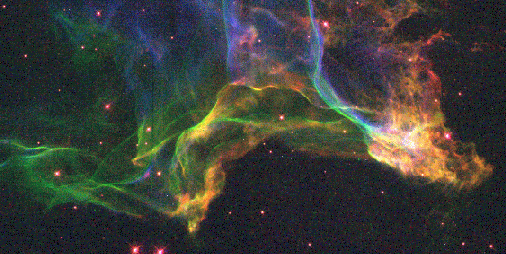Explanation: 15,000 years ago a star in the constellation of Cygnus exploded -- the shockwave from this supernova explosion is still expanding into interstellar space! The collision of this fast moving wall of gas with a stationary cloud has heated it causing it to glow in visible as well as high energy radiation, producing the nebula known as the Cygnus Loop (NGC 6960/95). The nebula is located about 2500 light years away. The colors used here indicate emission from different kinds of atoms excited by the shock; oxygen-blue, sulfur-red, and hydrogen-green. This picture was taken with the Wide Field and Planetary Camera 2 on board the Hubble Space Telescope.
1999 2000 2001 2002 2003 2004 2005 2006 2007 2008 2009 2010 2011 2012 2013 2014 2015 2016 2017 2018 2019 2020 2021 2022 2023 2024 2025 |
Yanvar' Fevral' Mart Aprel' Mai Iyun' Iyul' Avgust Sentyabr' Oktyabr' Noyabr' Dekabr' |
NASA Web Site Statements, Warnings, and Disclaimers
NASA Official: Jay Norris. Specific rights apply.
A service of: LHEA at NASA / GSFC
& Michigan Tech. U.
|
Publikacii s klyuchevymi slovami:
nebula - Sverhnovye - ostatok Sverhnovoi - NGC 6960 - tumannost' petlya Lebedya - supernova - supernova remnant
Publikacii so slovami: nebula - Sverhnovye - ostatok Sverhnovoi - NGC 6960 - tumannost' petlya Lebedya - supernova - supernova remnant | |
Sm. takzhe:
Vse publikacii na tu zhe temu >> | |
